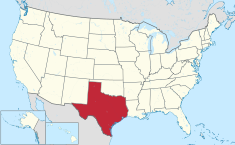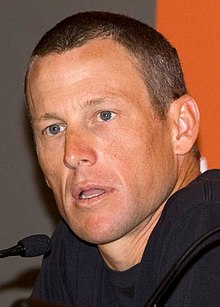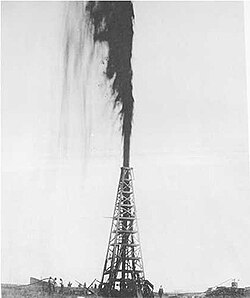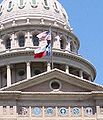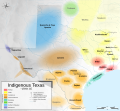
Back Portal:Texas Spanish Portail:Texas French Portale:Texas Italian Portal:Texas Portuguese Портал:Техас Russian
The Texas Portal
Texas (/ˈtɛksəs/ TEK-səss, locally also /ˈtɛksɪz/ TEK-siz; Spanish: Texas or Tejas, pronounced [ˈtexas]) is the most populous state in the South Central region of the United States. It borders Louisiana to the east, Arkansas to the northeast, Oklahoma to the north, New Mexico to the west, and the Mexican states of Chihuahua, Coahuila, Nuevo León, and Tamaulipas to the south and southwest. Texas has a coastline on the Gulf of Mexico to the southeast. Covering 268,596 square miles (695,660 km2), and with over 30 million residents as of 2023, it is the second-largest U.S. state by both area and population. Texas is nicknamed the Lone Star State for its former status as an independent republic. The Lone Star can be found on the Texas state flag and the Texas state seal. Spain was the first European country to claim and control the area of Texas. Following a short-lived colony controlled by France, Mexico controlled the territory until 1836 when Texas won its independence, becoming the Republic of Texas. In 1845, Texas joined the United States as the 28th state. The state's annexation set off a chain of events that led to the Mexican–American War in 1846. Following victory by the United States, Texas remained a slave state until the American Civil War, when it declared its secession from the Union in early 1861 before officially joining the Confederate States of America on March 2. After the Civil War and the restoration of its representation in the federal government, Texas entered a long period of economic stagnation. Historically, four major industries shaped the Texas economy prior to World War II: cattle and bison, cotton, timber, and oil. Before and after the Civil War, the cattle industry—which Texas came to dominate—was a major economic driver and created the traditional image of the Texas cowboy. In the later 19th century, cotton and lumber grew to be major industries as the cattle industry became less lucrative. Ultimately, the discovery of major petroleum deposits (Spindletop in particular) initiated an economic boom that became the driving force behind the economy for much of the 20th century. Texas developed a diversified economy and high tech industry during the mid-20th century. , it has the most Fortune 500 company headquarters (53) in the United States. With a growing base of industry, the state leads in many industries, including tourism, agriculture, petrochemicals, energy, computers and electronics, aerospace, and biomedical sciences. Texas has led the U.S. in state export revenue since 2002 and has the second-highest gross state product. (Full article...) Selected article -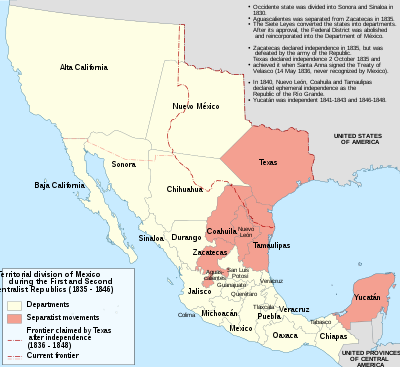 The Runaway Scrape events took place mainly between September 1835 and April 1836 and were the evacuations by Texas residents fleeing the Mexican Army of Operations during the Texas Revolution, from the Battle of the Alamo through the decisive Battle of San Jacinto. The ad interim government of the new Republic of Texas and much of the civilian population fled eastward ahead of the Mexican forces. The conflict arose after Antonio López de Santa Anna abrogated the 1824 Constitution of Mexico and established martial law in Coahuila y Tejas. The Texians resisted and declared their independence. It was Sam Houston's responsibility, as the appointed commander-in-chief of the Provisional Army of Texas (before such an army actually existed), to recruit and train a military force to defend the population against troops led by Santa Anna. Residents on the Gulf Coast and at San Antonio de Béxar began evacuating in January upon learning of the Mexican army's troop movements into their area, an event that was ultimately replayed across Texas. During early skirmishes, some Texian soldiers surrendered, believing that they would become prisoners of war — but Santa Anna demanded their executions. The news of the Battle of the Alamo and the Goliad massacre instilled fear in the population and resulted in the mass exodus of the civilian population of Gonzales, where the opening battle of the Texian revolution had begun and where, only days before the fall of the Alamo, they had sent a militia to reinforce the defenders at the mission. The civilian refugees were accompanied by the newly forming provisional army, as Houston bought time to train soldiers and create a military structure that could oppose Santa Anna's greater forces. Houston's actions were viewed as cowardice by the ad interim government, as well as by some of his own troops. As he and the refugees from Gonzales escaped first to the Colorado River and then to the Brazos, evacuees from other areas trickled in and new militia groups arrived to join with Houston's force. (Full article...)Selected biography -Lance Edward Armstrong (né Gunderson; born September 18, 1971) is an American former professional road racing cyclist. He achieved international fame for winning the Tour de France a record seven consecutive times from 1999 to 2005, but was stripped of his titles after an investigation into doping allegations, called the Lance Armstrong doping case, found he used performance-enhancing drugs over his career. He is currently banned for life from all sanctioned bicycling events. At age 16, Armstrong began competing as a triathlete and was a national sprint-course triathlon champion in 1989 and 1990. In 1992, he began his career as a professional cyclist with the Motorola team. He had success between 1993 and 1996 with the World Championship in 1993, the Clásica de San Sebastián in 1995, Tour DuPont in 1995 and 1996, and a handful of stage victories in Europe, including stage 8 of the 1993 Tour de France and stage 18 of the 1995 Tour de France. In 1996, he was diagnosed with a potentially fatal metastatic testicular cancer. After his recovery, he founded the Lance Armstrong Foundation (now the Livestrong Foundation) to assist other cancer survivors. (Full article...)Texas news
Wikinews Texas portal
ListsState symbols
Texas topicsSelected imageCities -Richardson is a city in Dallas and Collin counties in the U.S. state of Texas. As of the 2020 United States census, the city had a total population of 119,469. Richardson is an inner suburb of the city of Dallas. It is home to the University of Texas at Dallas and the Telecom Corridor, with a high concentration of telecommunications companies. More than 5,000 businesses have operations within Richardson's 28 square miles (73 km2), including many of the world's largest telecommunications and networking companies, such as AT&T, Verizon, Cisco Systems, Samsung, ZTE, MetroPCS, Texas Instruments, Qorvo, and Fujitsu. Richardson's largest employment base is provided by the insurance industry, with Blue Cross and Blue Shield of Texas's headquarters, a regional hub for the insurance company GEICO, regional offices for United Healthcare, and one of State Farm Insurance's three national regional hubs located in the community. (Full article...)General imagesThe following are images from various Texas-related articles on Wikipedia.
CategoriesSelect [►] to view subcategories
Related pages
Attractions
 Things you can doAssociated WikimediaThe following Wikimedia Foundation sister projects provide more on this subject:
SourcesMore portals | ||||||||||||||||||||||||||||||||||||||||


